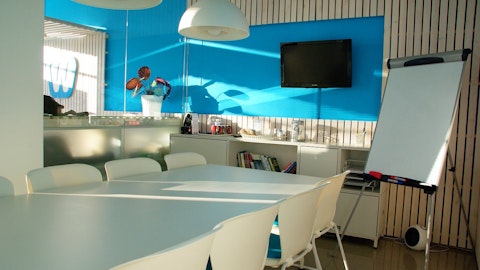Stephen Farrell: And I might have missed this at the beginning. What were the biggest drivers in the operating expense growth at those two properties?
David deVilliers: They’re across the board, probably one of the biggest ones. And Maren was — we had some utility issues, and so that was pretty big. And the other two things Stephen, One is security. D.C., like in a lot of these cities have had problems with security. And we wanted to get out in front of the problem. So security was definitely higher there. And also rent collections, we are slowly getting better because we were unable to generate the collection process because of COVID. COVID, they did not allow people to get thrown out. You couldn’t go to court, you couldn’t do anything. And so there’s an incredible overhang that is slowly starting to work its way through the system. It used to take up until sometime in the beginning of ’23, it used to take over a year to start and complete the process of going through trying to collections and then ultimately, fictions to get the properties back.
Now it’s down to about seven months. So we’re going in the right direction. But those are probably the two biggest reasons.
Stephen Farrell: And we saw with Bryant Street when you refinanced the construction loan, the bank required us to commit some more capital. And I’m seeing this trend continue, whether it’s construction loans or permanent financing that banks are refinancing at 50% to 60% LTVs as opposed to 70%. And I think there’s an opportunity to provide a GAAP financing to the borrowers so that they can maintain their debt and equity levels. And I know FRPH is not a lender, but there was an opportunity to provide that GAAP financing along with the equity component. Would you consider it?
David deVilliers: You mean the Bryant Street?
Stephen Farrell: No, for general properties.
David deVilliers: Just generally?
Stephen Farrell: Yes.
David deVilliers: I would say probably — generally, I would probably say no. We’ve got a pretty strong development pipeline. We’re focusing more on the industrial side in the near term, but we have some really good locations and some good projects in the multifamily side, too. So we don’t — we want to maintain as much dry powder as we can. And so I don’t see us and I’d certainly defer to John, but I don’t see us going out and being mezzanine lenders or that kind of stuff.
John Baker: No, I think — yes, you’re absolutely right, David. I think we’re going to use our equity to protect our own assets, but we’d have to get I think, number one, we are more than comfortable with the amount of exposure we have to the D.C. apartment marketplace right now. I don’t think we’re looking for additional exposure, and we would have to get really, really smart on another asset or another marketplace before we did something like that. And I just don’t think that’s the best piece of our time, more money. But you’re right, that is an interesting opportunity. That’s just not — I don’t think we have the bandwidth to take on kind of an additional investment strategy.
Stephen Farrell: Now that it’s understandable. And with Amber Ridge, all the lots are sold, is there any more interest or principal payments that will come in from that?
David deVilliers: Pretty much, no. It’s — we’re just kind of wrapping it up. There’s not a whole lot left, Stephen. There’s some closing out of bonds and that kind of stuff before we can close the…
Stephen Farrell: David, correct me if I’m wrong, but aren’t there some funds that are going to be released because I think if I’m right, the overall expected return of capital — return of principal and interest and profit of $22 million. And right now, we’ve received $20.2 million.
David deVilliers: Yes. There’s — from a cash standpoint, there’s still roughly $700,000 that is — we are holding as the lender to complete some of the remaining programs. And so we haven’t finalized the actual interest and profit to FRP, but when the dust settles, we believe it’s going to be about $4 million in interest and profit we received from that project, which will probably be tallied out sometime in the first or second quarter.
Stephen Farrell: Last question before I turn it over. The warehouse in Aberdeen, how much development cost was funded in 2023?
David deVilliers: I think it was about 7 — would have been about $17 million, Jon, are you there? Can you help me with that?
John Baker: $16 million is what I remember, but…Yes, I look I was actually looking at the Amber Ridge issue. What was the question again?
David deVilliers: Chelsea. Chelsea, how much money have we put out in Chelsea. And I assume, does that also include what we have in the land?
John Baker: It would. Yes. I’ll pull it up. Is there — mean time — is there another question?
David deVilliers: Actually, Stephen, let’s see. Chelsea, Chelsea. No, I don’t have it. Spec buildings, we spent — we incurred in ’23, about $9 million.
Stephen Farrell: s Plus the land gets to the 30%?
David deVilliers: Yes.
Operator: [Operator Instructions] We will take our next question from Bill Chen with Rhizome Partners.
Bill Chen: Hi guys. Good to have you join the call. Could you provide a little more detail on the Florida industrial joint venture?
David deVilliers: Yes. I mean it’s — we’ve always, again, take it — take a step back. We’ve always — likely done with the multifamily. Bill, we’ve always been — we’ve been looking to expand our platform and our program, and we’ve always felt the best way to do that was to find people and locations where the project was actually going to take place. And we found — I’ve had a relationship with one of the people for 20 years. You move back to Carl Gables, Florida. And anyway, they came to us late last year and said, look, we’ve got this project halfway between Orlando and Tampa, literally right on I mean, which is a main thoroughfare between the two areas. The market is very strong, and it’s a 215,000 square foot building that we’re working on developing.


